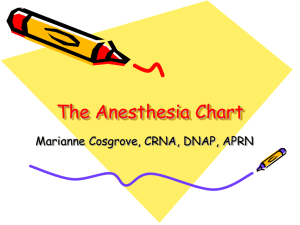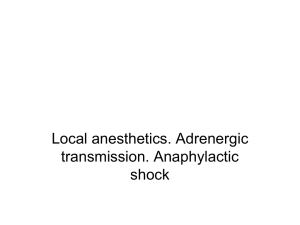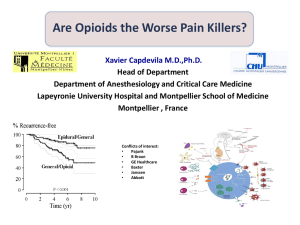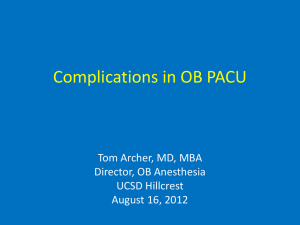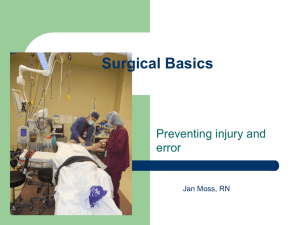Drug List
advertisement
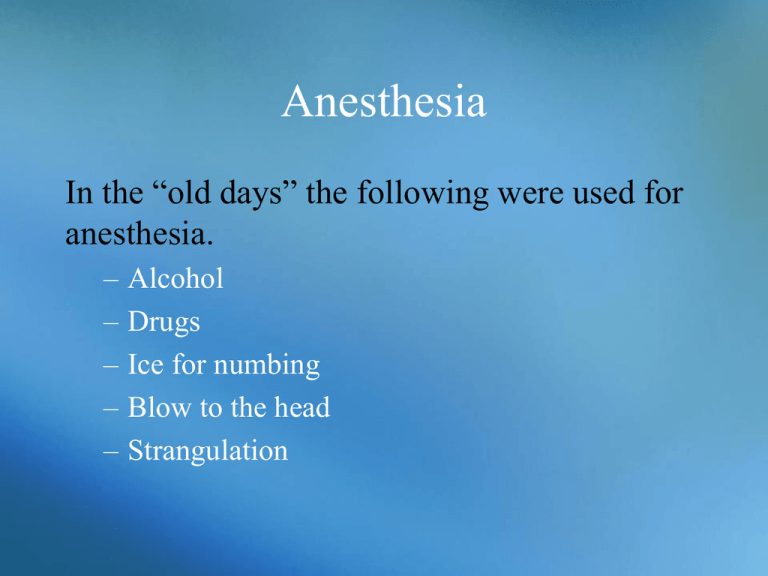
Anesthesia In the “old days” the following were used for anesthesia. – – – – – Alcohol Drugs Ice for numbing Blow to the head Strangulation Anesthesia Now, anesthesia is designed to focus on specific systems, such as • Nervous system • Skeletal system • Respiratory system • GI system • Endocrine system • Hepatic system • Cardiovascular system Anesthesia Goals of Balanced Anesthesia – Amnesia (Loss of memory) – Adequate Muscle Relaxation – Adequate Ventilation – Pain Control Types of Anesthesia • Preansthetics agents • General (inhaled: desflurane, halothane, isoflurane, Nitrous oxide, sevoflurane, enflurane; IV: barbiturate, benzodiazepines, ketamine, opoids, propofol, etomidate) • Local ( Bupivacaine, Lidocaine, Procaine, Tetracaine) General Anesthesia Preanesthetic Medications (antiemetics, muscle relaxants, Anticholinergics, antihistamines, Benzodazepines, Opioids) – – – – Control sedation Reduce postoperative pain Provide amnesia Decrease anxiety Discussion What are some of the indicators used to access general anesthesia? Answer: Blood pressure, hypervolemia, oxygen level, pulse, respiratory rate, tissue perfusion, urinary output General Anesthesia Malignant Hyperthermia – Side effect of anesthesia • Fever of 110°F or more • Life threatening – Treatment: dantrolene (Dantrium) Drug List Inhalant Anesthetics • • • • • desflurane (Suprane) enflurane (Ethrane) halothane isoflurane (Forane) nitrous oxide Inhalant Anesthesia Side Effects • Causes reduction in blood pressure • May cause nausea and vomiting nitrous oxide • Causes analgesia only; no amnesia or relaxation • May be given alone or may be given with more powerful anesthetics to hasten the uptake of the other agent (s) • Commonly used for dental procedures • Rapidly eliminated desflurane (Suprane) • Has rapid onset and recovery • Often used in ambulatory surgery Intravenous General Anesthesia • Often dispensed by IV drip • Very lipid soluble Drug List Injectable Anesthetics • • • • • • • etomidate (Amidate) fentanyl (Duragesic, Sublimaze) fentanyl-droperidol ketamine (Ketalar) morphine propofol (Diprivan) sufentanil (Sufenta) Drug List Injectable Anesthetics Barbituates – methohexital (Brevital) – thiopental (Pentothal) Benzodiazepines – diazepam (Valium) – lorazepam (Ativan) – midazolam (Versed) propofol (Diprivan) • Used for maintenance of anesthesia, sedation, or treatment of agitation • Has antiemetic properties – – – – Drowsiness Respiratory depression Motor restlessness Increased blood pressure fentanyl • Dosage Forms – IV – patch – lozenge for children • Used extensively for open-heart surgery due to lack of cardiac depression Benzodiazepines • Used for induction, short procedures, and dental procedures • Useful in controlling and preventing seizures induced by local anesthetics • midozolam (Versed) – fastest onset of action – greatest potency – most rapid elimination Antagonist Agents Antagonist agents reverse benzodiazepine and narcotic overdose. Drug List Antagonist Agents • flumazenil (Romazicon) • nalmefene (Revex) • naloxone (Narcan) Neuromuscular Blocking Agents • Causes immediate skeletal muscle relaxation. – Short Duration – Intermediate Duration – Extended Duration • Used to facilitate endotracheal intubation. – Allows for easier insertion of endotracheal tube. – Keeps airway open. Drug List Neuromuscular Blocking Agents • • • • • • • atracurium (Tracrium) cisatracurium (Nimbex) mivacurium (Mivacron) pancuronium rocuronium (Zemuron) succinylcholine (Quelicin) vecuronium (Norcuron) succinylcholine (Quelicin) • Often called “sux.” • Only depolarizing agent. All others work as competitive antagonists to ACh receptors. • Persistent depolarization at motor endplate. • Causes sustained, brief period of flaccid skeletal muscle paralysis. Reversal of Neuromuscular Blocking Agents • Increases the action of acetylcholine by inhibiting acetylcholinesterase • Used for reversal of nonpolarizing agents Drug List Anticholinesterase Agents • edrophonium (Enlon) • neostigmine (Prostigmin) • pyridostigmine (Mestinon) Local Anesthesia Relieves pain without altering alertness or mental function. Local Anesthesia Variety of Dosage Forms – – – – – Topical Superficial injection (infiltration) Nerve block IV Spinal Under what conditions would a local anesthetic be used over a general anesthetic? Answer: It is chosen when a well-defined area of the body is targeted. Discussion Local anesthetics are classified by their chemistry into two classes. Ester Amides Local Anesthesia Esters – Short acting – Metabolized in the plasma and tissue fluids – Excreted in urine Local Anesthesia Amides – Longer acting – Metabolized by liver enzymes – Excreted in urine Drug List Local Anesthesia Esters • benzocaine (Americaine) • chloroprocaine (Nesacaine) • dyclonine (Cēpacol Maximum Strength) • procaine (Novocain) • tetracaine (Cēpacol Viractin, Pontocaine) Drug List Local Anesthesia Amides • bupivacaine (Marcaine) • levobupivacaine (Chirocaine) • lidocaine (L-M-X, Solarcaine, Xylocaine) • lidocaine-epinephrine (Xylocaine w/ Epinephrine) • lidocaine-prilocaine (EMLA) • mepivacaine (Carbocaine) What functions are lost with local anesthetics? Answer – – – – Pain perception Temperature Touch sensation Skeletal muscle tone


